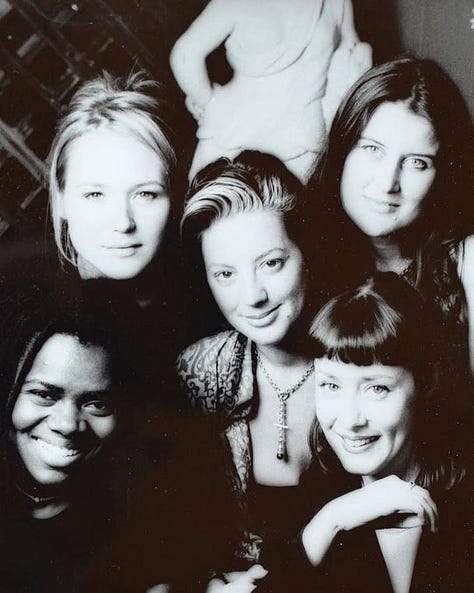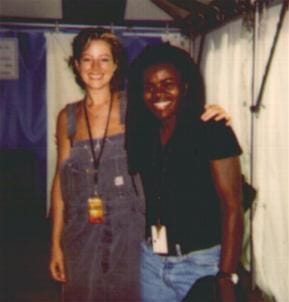Tracy Chapman at Lilith Fair 1997: No Cameras, No Fuss, Just Fire
A look back at the rare, electric performances that made Tracy Chapman the heart of a revolutionary festival.
In the summer of 1997, a quiet revolution took the stage. Lilith Fair wasn’t just a music festival; it was a cultural shift led by women who refused to be sidelined. At the center of it all, in just ten unforgettable performances, was Tracy Chapman. Here's the story of how it all came together.
What was the origin of the Lilith Fair festival, and why was it created?
The Lilith Fair festival was co-founded in 1996 by Canadian singer-songwriter Sarah McLachlan and three associates.
Initially, McLachlan's desire to create the festival was selfish; she wanted to bring together the artists whose music she appreciated but had never seen perform due to her constant touring schedule.
But it quickly became clear that one of the main objectives was to combat sexism in the music industry. Indeed, female artists often faced systemic reluctance when it came to scheduling them alongside other female artists at festivals or radio broadcasts. Sarah McLachlan said:
“Like, I'd walk in and do an interview and they said, 'Well, we'd love to add this song but we can't add you this week because we had a Tori Amos or because we added Tracy Chapman or because we added Sinéad O'Connor. And it was extremely frustrating. So the beginning of this was just born out of a desire to come together as a community. And it became this — we're going to break down some barriers. We're going to prove these guys wrong." 1
In the '90s, the two major summer festivals in the U.S. were H.O.R.D.E and Lollapalooza. Take a look at the lineups (click on the links) to see the systemic misogyny in the music industry: how many female artists or groups led by women were scheduled to perform at these festivals? Not many.
With Lilith Fair, McLachlan aimed to demonstrate the viability, profitability, and popularity of an all-female tour. And it was! For the one and a half million fans who attended the Lilith Fair shows from 1997 to 1999, the festival offered a radically different musical experience than was available at the time. The festival grossed over $60 million in ticket sales and raised more than $10 million for charity, making it the top-grossing music festival of the late 1990s.
In a 1999 interview, Tracy mentioned the festival:
“Lilith Fair tapped into an audience that really hadn’t been considered before. Other festivals I think mainly attracted teenage boys, college age men, but there was no-one really trying to play to all these girls out there – except the Spice Girls – so I think that was part of why it worked so well.” 2
But why was the festival named "Lilith Fair"?
The name of the festival, "Lilith Fair," comes from the Jewish goddess Lilith and the term "Fair," which means equality and inclusion as well as a gathering or festival.
Sarah McLachlan explained everything in the great article The Oral History of Lilith Fair, As Told By the Women Who Lived It published on Glamour on July 5, 2017
“I was talking to a friend [writer Buffy Childerhose] about the concept and said, “I need a name.” She goes, “Have you heard the story of Lilith?” In Hebrew mythology Lilith is Adam’s first wife, before Eve. He asked her to lie beneath him, and she said, “No, we’re equal.” She left, and she was made into a cautionary tale. I thought, Perfect protagonist! Obviously words are important to me, and Lilith on its own didn’t seem like enough. I loved the play on words of fair being the sort of old-fashioned fair, and fair being equal.”
Obviously, this dual meaning aligned with the festival's purpose of promoting equality and inclusivity for women in music.
The 1997 edition of the Lilith Fair Festival
The first festival took place from July 5 to August 24, 1997. Thirty-seven concerts were held in the United States and Canada. With a capacity of 670,500 seats, most of the concerts sold out.
Main stage performers in 1997 were the following (in alphabetical order):
Fiona Apple
Tracy Bonham
Meredith Brooks
The Cardigans
Mary Chapin Carpenter
Tracy Chapman
Paula Cole
Shawn Colvin
Sheryl Crow
Indigo Girls
Emmylou Harris
Jewel
Lisa Loeb
Sarah McLachlan
Joan Osborne
Suzanne Vega



Many other artists were asked to perform for the first edition, but “certain people were either on the road already, sick of touring, in the studio and one or two said plain-old, ‘No, it’s not my scene.’” said Sarah McLachlan.
Queen Latifah and Sinead O’Connor weren’t available in 1997 but performed on the following editions. Neneh Cherry and Lauryn Hill were scheduled for the second edition but had to cancel at the last minute.
Bjork, Ani DiFranco, and Tori Amos simply said No.
The lineup of the secondary stages at the various editions of the Lilith Fair was truly impressive; some artists then became stars with global hits: in 1997, Dido and Morcheeba; in 1998, India Arie (and Sixpence None The Richer, remember the hit “Kiss Me”?); and in 1999, Christina Aguilera and Nelly Furtado. All these artists were not very well-known before performing at the Lilith Fair. It must have been quite a job to choose them. Just for the 1997 edition, McLachlan explained that 700 bands featuring women applied for 25 slots on two auxiliary stages.3 With the success of the first edition, the applications must have exploded for the following editions.
But then, how did Tracy end up invited on the Lilith Fair tour?
Sarah McLachlan met her, invited her, and Tracy said yes; it's as simple as that. In a great joint interview published before the tour that I recommend you read, Sarah recounts how it happened:
Sarah McLachlan: (...) I’m so happy you said yes to coming along.
Tracy Chapman: Well, it sounded like such a great idea when you mentioned it to me.
Alison Powell: When was that?
Sarah McLachlan: I met Tracy for the last time at Christmas. I’m pretty shy, but I just bowled into her dressing room and said. “Hey, how ya doin’? What’re you up to this summer?”
Tracy Chapman: You didn’t seem shy at all.
Sarah McLachlan: I think I kind of freaked you out. I’m sorry, I was a little over the top. I was nervous to talk to you ’cause I’m no good at selling myself.4
More seriously, in the rest of the interview, Tracy indirectly explains why she accepted this project:
AP: How about this for a wake-up question: If the established tours, like Lollapalooza and H.O.R.D.E, hadn’t become so masculine in recent times, do you still think there would be a Lilith?
SM: Oh, definitely. Lilith Fair was only slightly begun for reactionary masons. I think it’s been coming for a long time. In fact, it’s odd to have to put this out as something new and different—Tracy, I think you’ll understand this. People ask, “So what do you think about this new fad of women in music?” And I think, what do you mean, fad? Have women never made music before?
AP: I think what people noticed was that there were suddenly a lot of women clustered at the top of the charts.
TC: The chart position is what makes R.
AP: Tracy, you were a part of that.
TC: Yeah. But I think I know where Sarah was going with what she was saying. Of course women throughout history have always been making music and crossing genres too, but it’s only in recent years that the press has made it seem as if these movements are moments in time when women are somehow becoming more popular or, in some cases, dominating the industry, which of course is far from the reality. But there are more opportunities out there right now for women who write their own songs and play on their own records.
SM: Yeah. If we had tried to put together a women’s music festival like this five years ago, the promoters would’ve laughed at us. Now they’re so excited about all these women—it’s nice to see that some things can turn around quite quickly. Who knows why? I guess people just had a desire to hear something different, and women were offering it.
AP: But Sarah, that was hardly still the early days of the women’s movement.
SM: Which is pretty sad.
TC: Yes, but even though I think all women owe something to the women’s movement—the right to vote, to own property, and to have control over our bodies and lives—the music made by the women who are part of this tour doesn’t necessarily have anything to do with politics. The position we are in also has a lot to do with the pace of music—a lot has happened in it.
SM: The curious thing about all this is that the idea for Lilith came from a humble idea, which was: Wow, wouldn’t it be fun to get together with a bunch of women I love and admire and have a tour? I never get to see anybody play live, so it’s really a selfish act.
TC: I was thinking that too. I haven’t seen a lot of the women who’ll be playing on the tour. It reminds me of when I did the Amnesty International shows. I’d never seen Peter Gabriel or Bruce Springsteen or Sting play live, so as much as I was a participant, I also felt like a fan, and I feel the same way about Lilith: It’s a free concert every night.
SM: Yeah, that’s the prime motivator for me. Then along came all these huge feminist undercurrents, which of course are going to exist. But like Tracy said, the important thing to focus on is the incredible diversity of music that’s happening.
I'm not going to copy and paste the entire interview for you; just read it :)

It made perfect sense for Tracy to participate, especially since she was at the peak of her popularity in the United States at that point in her career. Her latest album, New Beginning, released in 1995, had sold 5.3 million copies in the United States. The single "Give Me One Reason" sold more copies than "Fast Car": 1.35 million versus 1.21 million.
Why did Tracy perform "only" 10 times on this tour?
Keep reading with a 7-day free trial
Subscribe to Tracy Chapman In Depth - Tracy Chapman Online’s Newsletter to keep reading this post and get 7 days of free access to the full post archives.




